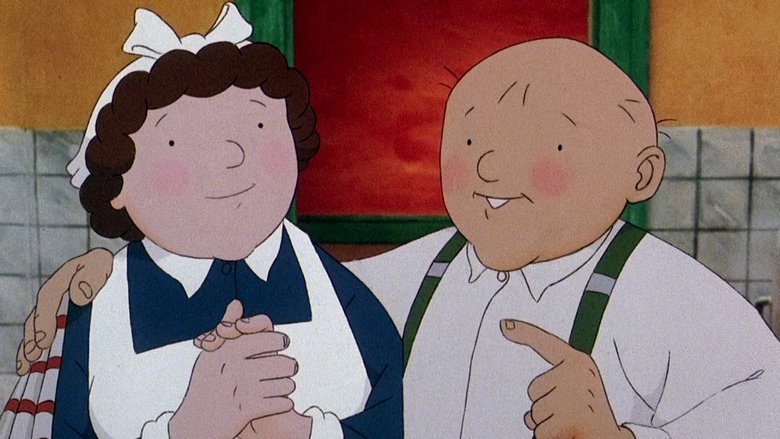← Back to Reviews

in

When the Wind Blows, 1986
Elderly couple Jim (John Mills) and Hilda (Peggy Ashcroft) follow government directions to prepare for an imminent nuclear attack. When the bomb drops, the couple survives, sheltering behind their detached doors. But in the days following the attack, the couple begins to experience the consequences of radiation exposure, unable to comprehend that this is nothing like their experiences during WW2.
Bleak, bleak, bleak.
It doesn’t take long for the relentless British cheeriness of Jim and Hilda to become incredibly macabre. The easy temptation is to fall into a sort of contempt for these people, with their naivete and blind faith in their government and the social systems that have always surrounded them. (Hilda repeatedly cannot conceive of the idea that the local shop won’t be open). I think that you might look at this film and scoff at their stupidity, but I would say that stupidity isn’t what we’re seeing: it’s denial.
Let’s assume that Jim and Hilda were incredibly astute: what are they supposed to do? Is there a way that they would have come out better if they exactly understood the nature of what was happening to them? Morbidly, I think that pre-emptive suicide is basically the only “solution” that presents itself. These rural, elderly citizens are in no position to prevent nuclear war, and neither do they have the resources to even hope to survive it.
The denial about what is happening to them is the most painful part to watch. An increasingly perturbed Jim tries to chalk Hilda’s bleeding gums up to the shock from the dropping of the bomb. They repeatedly remind each other about their son’s common sense, not wanting to consider the idea that their child (and daughter-in-law, and grandchildren) might be dead.
It’s all helpless and hopeless, and I couldn’t help but think of the people right now, in this moment, who are living through fear and trauma and pain and death that is none of their doing, and that they are powerless to escape.
The animation style is very effective. While most of the film is hand-drawn, with soft and round figures, many shots show real-world footage, and sometimes real settings in which the characters are placed. The contrast of a real trashed kitchen with the doll-like figures of Bill and Hilda highlights their innocence in the face of the horror of war.
One element of the film reminded me of something I read in an article about climate change. Basically, people vastly underestimate the severity and overestimate their ability to cope with challenges they haven’t faced before. The couple assumes that their experience will be like the Blitz, and approach their preparations with something bordering on nostalgia. As they create a little tent of dismantled doors and grouse over how to take care of bathrooming needs, the sense of dread builds because they have no idea what they are up against.
Devastating, which is exactly its intention.

When the Wind Blows, 1986
Elderly couple Jim (John Mills) and Hilda (Peggy Ashcroft) follow government directions to prepare for an imminent nuclear attack. When the bomb drops, the couple survives, sheltering behind their detached doors. But in the days following the attack, the couple begins to experience the consequences of radiation exposure, unable to comprehend that this is nothing like their experiences during WW2.
Bleak, bleak, bleak.
It doesn’t take long for the relentless British cheeriness of Jim and Hilda to become incredibly macabre. The easy temptation is to fall into a sort of contempt for these people, with their naivete and blind faith in their government and the social systems that have always surrounded them. (Hilda repeatedly cannot conceive of the idea that the local shop won’t be open). I think that you might look at this film and scoff at their stupidity, but I would say that stupidity isn’t what we’re seeing: it’s denial.
Let’s assume that Jim and Hilda were incredibly astute: what are they supposed to do? Is there a way that they would have come out better if they exactly understood the nature of what was happening to them? Morbidly, I think that pre-emptive suicide is basically the only “solution” that presents itself. These rural, elderly citizens are in no position to prevent nuclear war, and neither do they have the resources to even hope to survive it.
The denial about what is happening to them is the most painful part to watch. An increasingly perturbed Jim tries to chalk Hilda’s bleeding gums up to the shock from the dropping of the bomb. They repeatedly remind each other about their son’s common sense, not wanting to consider the idea that their child (and daughter-in-law, and grandchildren) might be dead.
It’s all helpless and hopeless, and I couldn’t help but think of the people right now, in this moment, who are living through fear and trauma and pain and death that is none of their doing, and that they are powerless to escape.
The animation style is very effective. While most of the film is hand-drawn, with soft and round figures, many shots show real-world footage, and sometimes real settings in which the characters are placed. The contrast of a real trashed kitchen with the doll-like figures of Bill and Hilda highlights their innocence in the face of the horror of war.
One element of the film reminded me of something I read in an article about climate change. Basically, people vastly underestimate the severity and overestimate their ability to cope with challenges they haven’t faced before. The couple assumes that their experience will be like the Blitz, and approach their preparations with something bordering on nostalgia. As they create a little tent of dismantled doors and grouse over how to take care of bathrooming needs, the sense of dread builds because they have no idea what they are up against.
Devastating, which is exactly its intention.
